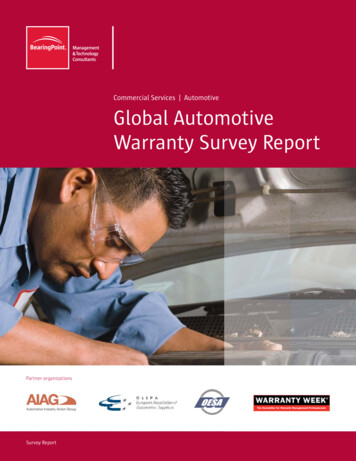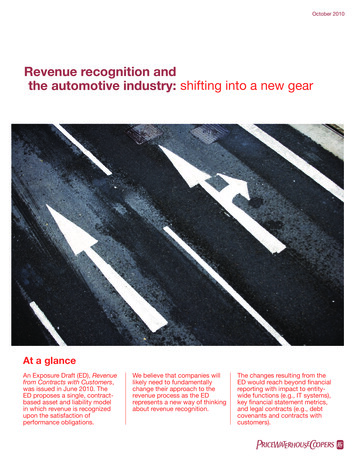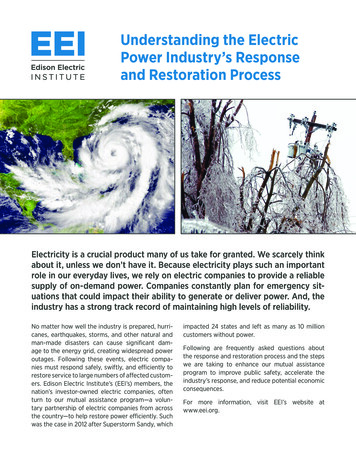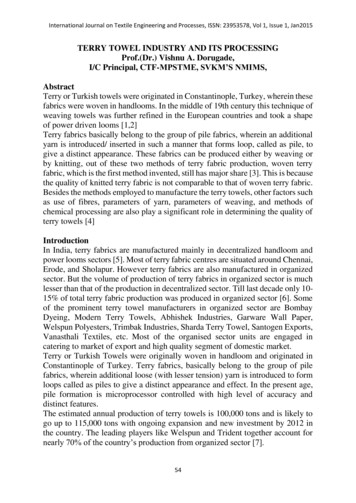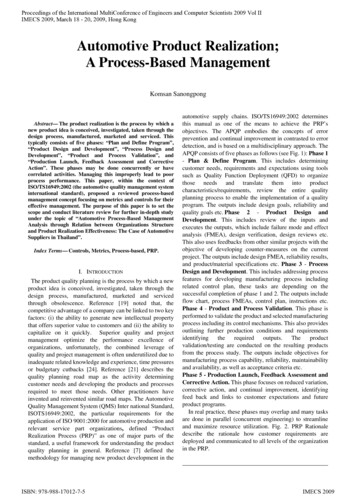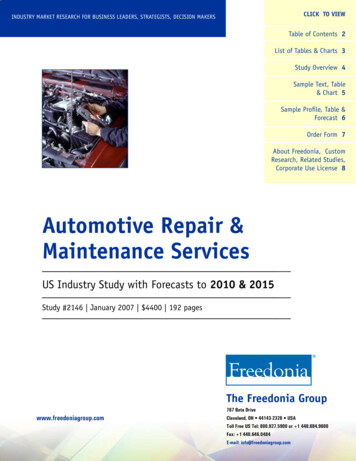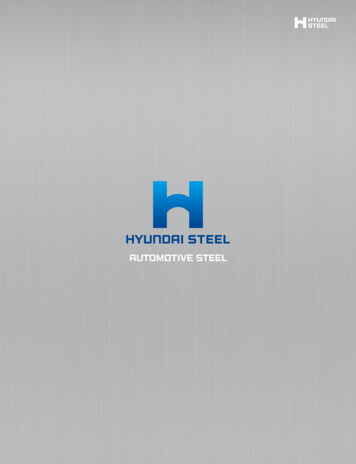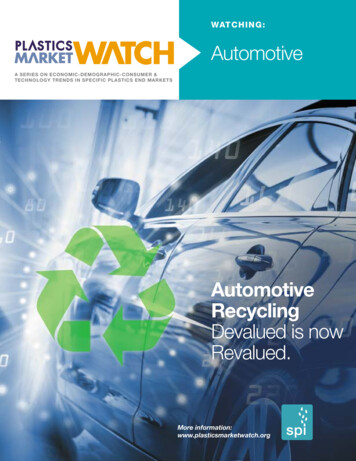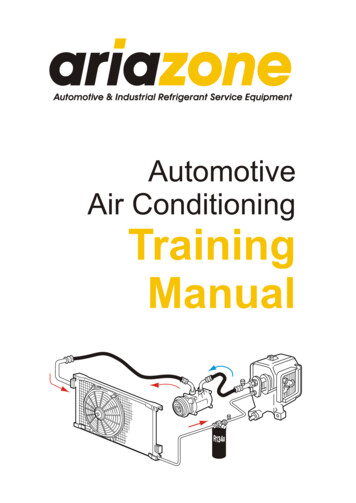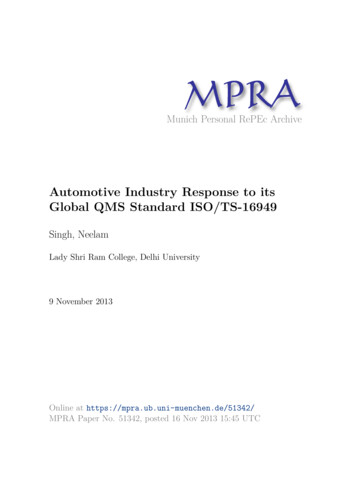
Transcription
Munich Personal RePEc ArchiveAutomotive Industry Response to itsGlobal QMS Standard ISO/TS-16949Singh, NeelamLady Shri Ram College, Delhi University9 November 2013Online at https://mpra.ub.uni-muenchen.de/51342/MPRA Paper No. 51342, posted 16 Nov 2013 15:45 UTC
Automotive Industry Response to its Global QMS Standard ISO/TS-16949Neelam SinghAssociate Professor, Economics Dept.Lady Shri Ram College (Delhi University)New Delhi 110024, India.neelamsi@gmail.comAbstract: With increasing globalization, the intense competition and customer-pressure havespurred many producers from developing/ emerging countries to adopt the best management andorganizational practices. The quality issues are paramount for automotive manufacturing. Themultiplicity of Quality Management System (QMS) Standards prevalent till the 1990s finallygave way to development of a harmonized automotive industry-specific QMS, namely ISO/TS16949. This paper analyzes the major factors motivating firms to adopt this Standard: its qualitysignaling function, especially in international business, and facilitative role in moving up thesupply chain. We investigate the inter-national and inter-regional concentration of ISO/TS-16949certificates and relate those changes to the automotive industry dynamics. Among the topcertifying nations China, India and Brazil included these certificates and ‘cars andcommercial vehicles’ produced are highly correlated. A moderate-to-high worldwide growth ofthis certification is probable in near future with its gaining popularity among Tier-2 suppliers andfor two/ three-wheeler automotive production. The Indian evidence indicates a sizeableproportion of car and commercial vehicle plants being ISO/TS-16949 certified and a highcertification incidence among large and medium-large auto component firms. We suggest thecreation of a Centre to encourage and prepare SMEs and provide financial assistance for ISO/TS16949 certification.Keywords: Quality Management System, QMS; ISO/TS-16949 Standard; automotive industry;international QMS Standard; IndiaJEL: L15; L62; F231
1. IntroductionThe globalization has generally intensified the competition in international as well as domesticmarkets. Consumers now demand enhanced product quality and variety. In the automotive sectorthe global and regional outsourcing of components has risen over time (e.g. Humphrey andMemedovic 2003). 1 This has raised for auto component suppliers from emerging markets theiroptimal fixed outlays for quality and productivity upgradation (Sutton 2007). For them therewards of moving up the supply chain lie in relatively more assured/ longer contracts, higherprofitability and less vulnerability, as well as greater involvement in new product developmentby vehicle producers (Singh 2007 and 2010b). The associated challenges include, among others,crossing the quality thresholds, say by employing the world-class quality management practices.The quality improvement is a multifaceted activity. Here we confine our analysis to the qualitymanagement system (QMS) Standards. A QMS Standard a set of features present throughdocumented manuals and procedures apart from acting as a quality differentiator enhances theproductivity and delivery schedule performance by reducing the wastage & errors, andimproving the employees’ morale and working conditions. QMS certificates issued by anaccredited Certification Body are called accredits. The ISO-9000, based on process approach, isa voluntary and generic QMS Standard (a family), having 8 broad principles for quality systems;its Requirements, namely ISO-9001 can be applied to any sector. By December-end 2011 theISO-9001certifications issued globally in 180 countries were approx. 1112 thousand 2, ascompared to below 50 thousand in 1993 in 60 countries (ISO 2012); the number outside Europeand North America correspondingly jumped from approx. 6 thousand to 582 thousand. Theincreasing competition, insistence of multinational buyer-firms, and the government assistancehave led to its extensive worldwide adoption (Franceschini et al. 2011; Oke and Owaba 2007).However, a few industries where the quality issues are paramount have evolved their ownindustry-specific internationally harmonized QMS Standard. The automotive industry having theThe vehicle industry has regionalized production not as globalized as electronics and textiles; however, it isdominated by a small number of MNEs which generally produce in all major markets (Stanford 2010); apart fromhaving significant inter-sectoral linkages, for some economies – like Japan, Germany, Canada, Korea and Spain –the automotive sector contributes much to the exports, employment and GDP directly (p. 385).2Of these, China and India had 328213 and 29574 certificates, implying 29.53% and 2.66% global shares, and the1st and 7th ranks respectively. Incidentally the number of these certificates globally fell by 0.6% in 2011 over 2010.12
ISO/TS-16949 Standard (also called TS-16949), is one such case. 3 It is an ‘ISO-9000 plus’Standard in terms of the QMS requirements. By end-2011 the number of ISO/TS-16949certifications issued in 86 countries was 47.5 thousands. For the global automotive industry inthe 21st century there has been heightened competition and much restructuring of productionlocation. The geographical spread of ISO/TS-16949 certification analyzed in the present studyreflects this dynamics. Like Franceschini et al. (2011), we relate at country-level the ( 4wheeler) vehicle production and number of ISO/TS-16949 certificates. They predicted the totalISO/TS-16949 certificates to saturate around 43 thousand in 2012 (surpassed in 2010!). Weexpect instead a moderate to high overall growth of these certifications in near future due to: thelikely increasing adoption of this certification by producers and Tier-1 suppliers of two/ threewheeler vehicles, and by Tier-1 and Tier-2 suppliers to 4 wheeler manufacturers. As a specialcase this paper also examines separately the prevalence of ISO/TS-16949 QMS certificationsamong vehicle manufacturers and auto component producers operating in India a relativelybooming automotive market.Below Section 2 discusses briefly the development of ISO/ TS-16949 Standard its formulationand revisions. Section 3 examines the major drivers of adoption of this Standard by autocomponent and vehicle producers. Section 4 reports data on the global spread of this Standard,and analyzes the inter-national and inter-regional patterns of this certification, juxtaposed to theautomotive production. Section 5 focuses on the rapid growth of the Indian automotive sector inrecent years, and other factors propelling automotive firms in India to improve the qualityparameters and management systems. Section 6 examines the Indian evidence on ISO/ TS-16949certifications. Section 7 concludes and offers a few policy suggestions.2. Development of Automotive Industry QMS Standard ISO/TS-16949The product quality is a critical concern in automotive sector. Vehicle manufacturers (also calledautomotive Original Equipment Manufacturers, OEMs) and governments are interested in thesafety and quality of vehicles sold, and therefore, also in the quality of auto components. With3There are specific QMS for medical devices (ISO-13485) and petroleum, petrochemical and natural gas (ISO/TS29001) industries too. There are special ISO-9001 guidelines for education (IWA 2) and local government (IWA.4).3
platform-sharing across a number of vehicle models – a general practice followed by automobilemanufacturers – the failure of a common key component poses larger risks (Bailey et al. 2010).Poor quality of vehicles can lead to excessive fuel consumption, high costs of dismantling &repairs, and accidents. In many advanced countries the vehicle sales are subjected to stringentproduct recall liabilities and severe penalties in accident lawsuits (Boehm and Ulmer 2008).By the mid-1980s automotive suppliers were subjected to several nation and customer specificregulations relating to quality management. In the mid-1990s in the USA the Big Three carproducers (General Motors, Ford and DaimlerChrysler) and major truck manufacturersformulated a common QMS Standard, QS-9000, based on ISO-9000:1994. Yet the multiplicityof QMS Standards prevailing in automotive sector and the lack of mutual recognition acrosscountries/ regions acted as a kind of trade barrier (Singh 2010a).The ISO/TS-16949 “--- standard was developed to satisfy a pressing need of the automotivesuppliers, which – since the 1990s – were subject to a confusing mass of military, national andcustomer standards” (Franceschini et al. 2011, p. 736). “ISO/TS 16949 eliminates redundancy,cost and administrative burdens imposed by multiple standard formerly mandated in variousgeographic regions” (Ostadi et al. 2010, p. 496). By dispensing with the need for multiple thirdparty registrations for global supply of auto components, the ISO/TS-16949 certificationfacilitates their international trade. Having this certification lessens the second-party (customer)audits; for suppliers, each such intensive assessment involves some disruption in routine work,associated paperwork and costs.Since 1999 the ISO/TS-16949 Standard, as a globally harmonized international QMS Standardfor the automotive sector, has created a single reference point. Here ‘automotive’ includes cars,trucks, buses and motorcycles. The ISO/TS-16949 certification can apply to any Tier ofautomotive supply chain, including heat treating, welding, painting, plating or other finishingservices. Apparently it is not applicable to component manufacturing sites supplying only to theaftermarket (and not parts specified by the customer).4
The ISO/TS-16949 Standard has been developed by the International Automotive Task Force,IATF – an ad-hoc group of major global vehicle producers and national automotive associations– and approved by the ISO technical committee ISO/TC 176 ‘Quality Management and QualityAssurance’, responsible for the ISO-9000 QMS. The IATF also manages the ISO/TS-16949accredits through its oversight offices. As per the IATF list updated on August 14, 2013, thereare 45 contracted ISO/TS-16949: 2009 Certification Bodies; among those, the Indian RegisterQuality Systems, IRQS, is based in India. 4The 1999 version of ISO/TS-16949 was aligned with the then prevalent U.S. (QS-9000),German, French and Italian QMS Standards for automotive sector – all based on ISO-9001:1994.The second edition ISO/TS-16949:2002, called TS-2, released in March 2002, incorporates theverbatim text of ISO-9001:2000. It adds certain specific requirements for the automobileindustry and automotive supply chain in areas like employee competence, design anddevelopment, production and service provision, monitoring, measurement, analysis andimprovement (Gryn 2003). The TS-2 allows OEMs to add their own, i.e. customer-specificrequirements. Further, it would be mandatory for any ISO/TS-16949:2002 certified firm to buyits automotive intermediates only from producers having at least the ISO-9001:2000 Standard.The third edition, ISO/TS-16949:2009 amends the ISO/TS-16949:2002 edition to ensurecompatibility with ISO-9001:2008, Quality management systems –Requirements, and to improveconsistency with the environmental management system Standard, ISO-14001:2004 (ISO 2009).There are no essential changes in the technical requirements. The IATF permitted a transitionperiod of 120 days from the publication date – June 15, 2009 – for organizations to comply withthe Standard's requirements. “The foundation of certainty that ISO/TS 16949:2009 provides interms of improved productivity, quality, and just-in-time logistics and delivery in the supplychain, is probably more essential than ever” (Joe Bransky, an IATF member, quoted in ISO2009).4Source: www.iatfglobaloversight.org, accessed August 30, 2013.5
3. Drivers of Adoption of ISO/TS-16949 StandardAn auto component producer may adopt the ISO/TS-16949 Standard for the internal efficiencyreason and/or as a marketing tool to emit quality signal. As reviewed below, the existingliterature indicates broadly two powerful influences of ISO/TS-16949 Standard on the certifiedauto component firms, more so in respect of exports than domestic sales. These effects are:quality signaling and being a facilitator in moving up the value chain; the former role itselfcontributes to the latter. In Section 3.1 we also examine the limited empirical micro-levelevidence on the choice of this certification by auto component producers. In Section 3.2 weexplain what motivates automobile manufacturers to opt for ISO/TS-16949 certification for theirproduction sites.3.1Motives for Auto Component ProducersThe automotive industry is tier-ized, as illustrated in Figure 1. Auto component supplies forfurther processing are made from lower Tiers (upstream suppliers) to higher Tiers and then fromTier-1 to the original equipment (vehicle) manufacturer, OEM. Tier-1 firms supply directly toOEMs; the firms selling assemblies/ modules to OEMs are sometimes called Tier-0.5 suppliers.A component producer may even operate at different Tiers for different items, thus playingdiverse roles. The direct and indirect supplies for original equipment (vehicle manufacturing) areknown as OE supplies. However, the supplies to OEMs may be partly for the aftermarket salesby OEMs, i.e. meant to be sold for vehicle-repair purpose; these supplies have to adhere to theOEM specifications. The total aftermarket/ replacement market, including also the directsupplies of components to it, is quite large in value terms (see Singh, 2010b).6
Figure 1: Auto Components: OEM and Replacement MarketsTier-3 supplier Tier-2 supplier Tier-1 supplier Aftermarket(outside the automotive OEMsupply chains)OEMNote: Adapted from Singh (2010b).Quality Signaling Role of QMSAn important factor motivating a producer to seek QMS certification is its quality signaling rolein the presence of a large number of potential suppliers of the product and their unobservableattributes (see e.g. Terlaak and King 2006). Hence customers prefer the ‘third party QMScertification’ assurance. 5 Without QMS certification, intensive time-consuming second-partyaudits of quality parameters of a prospective supplier are required especially cumbersome forpurchase contracts with foreign suppliers. However, sometimes potential overseas buyers maynot be fully convinced of the integrity and capabilities of an interested supplier’s ISO-9000Certifying Body, if non-accredited. The ISO/TS-16949 certification is credible and universallyrecognized. Moreover, this Standard is ‘ISO-9000 plus’ by way of some additional QMSrequirements for the automotive supply chain. Therefore, ceteris paribus, compared to ISO9000, the ISO/TS-16949 certification signals a superior QMS for automotive operations. Thequality signaling (differentiating) role played by ISO/TS-16949 accredit is stronger for buyersupplier transactions across nations and those between otherwise non-linked firms.5A QMS certification (registration) is usually valid for 3 years, and may be renewed. It being plant-specific, multiplant firms may obtain multiple certifications for identical or different QMS Standards across plants.7
With the formulation of ISO/TS-16949, globally a large number of Tier-1 suppliers, especiallythose exporting to OEMs, have been ‘pressurized’/encouraged by OEMs to adopt this Standard.Stating with a few OEMs in the early 2000s, at present many Tier-1 suppliers differentiatebetween their ISO/TS-16949 accredited and other suppliers. Now the vehicle manufacturersusually ask for ISO/TS-16949 certification or at least the compliance with this QMS of theirdirect (Tier-1) suppliers. For these transactions the general ISO-9000 Standard seems to haveceded the quality signaling/ differentiator role to the industry-specific Standard ISO/TS-16949(Singh 2010a and 2010b). Further, for the sake of consistency major global OEMs are interestedin having their entire supply chain, including their sub-contractors Tier-2 and Tier-3 suppliers,being ISO/TS-16949 certified. Even for international trade in standardized auto components thequality, delivery and logistic parameters have become more important over time. For diversifiedfirms producing components also for related sectors like rail transport and aerospace, beingISO/TS-16949 certified may emit quality signals to those potential customers as well.The case study evidence obtained by Sroufe and Curkovic (2008) indicates: the ISO/TS-16949registration signals a quality image to potential customers, improves on-time delivery, reducesdecline in defective parts per million and increases sales. Bevilacqua et al. (2011) find that theapplication of ISO/TS 16949:2009 yields high-quality products, improves the plant performanceand consolidates market position of the firm. Ostadi et al. (2010) in an empirical study of asample of thirty six ISO/TS-16949:2002 certified auto component SMEs in Iran – 4 producershaving 50 to 100 employees and the others even less – examine the motives and effects of thiscertification as perceived by the implementing managers. The motive was ‘to improve thecompany quality image’ (78%) and ‘to strengthen the quality management system’ (69%).Adopting the ISO/TS-16949 Standard brought the registered Iranian plants significant gains, likeenhancing the status of the organization, systematic documentation, better quality control,increased competing ability in sales, verifying the internal auditing system, etc.Moving up the Supply ChainThe potential rewards associated with higher Tier like Tier-1 sales have been mentioned inSection 1. Globally a significant proportion of automotive Tier-suppliers seem to haveprogressed over time to a higher Tier of the supply chain and have changed their product profile8
accordingly. Again the automotive purchases for vehicle or ‘Tier-1 Level’ production consist ofcritical/ key as well as other components. For a component producer-supplier at any given TierLevel, increasing the relative production of critical components which have more exactingquality and delivery requirements, is an implicit progress. Holding of ISO/TS-16949 certificate through its quality signaling role and the likely favourable influence of this QMS Standard on theproductivity and delivery schedule performance, as alluded above is expected to facilitatemoving up the supply chain. For export sales, this certification may play a far greater role inthese upward journeys, also because many global OEMs and even some Tier-1 auto componentfirms consider the ISO/TS-16949 certification of their vendors as mandatory or stronglypreferred, especially for purchase of key components.However, this expected facilitative role of ISO/TS-16949 Standard has been hardly investigatedempirically. Singh (2010b) provides supporting evidence relating to exports. She examines theexport behavior of auto component firms operating in India in terms of the type of QMS andother quality related factors, firm size, foreign financial and technical collaborations, isolationand cluster location variables, etc. She analyzes separately the determinants of different Levelsof exports – probability of being exporter to OEMs, to OEMs and/or Tier-1 firms, or at anyLevel (even to the aftermarket). Ceteris paribus, ISO/TS-16949 certified and bigger firms arefound to be far more likely to be exporters to OEMs, and to be exporters to ‘OEMs and/or highTier’ firms. Having a Quality-Incharge and having an internationally recognized Quality-Awardincrease the likelihood of being an OEM-Level exporter. Though the probability of exportparticipation (being an exporter) is unaffected by the ISO/TS-16949 certification, amongexporters the ISO/TS-16949 certified firms have a larger value of exports.As mentioned above, the major global OEMs now want even their Tier-2 and Tier-3 suppliers tobe ISO/TS-16949 certified. The OEMs are also intensifying their sales efforts in the aftermarketsegment. Hence for SMEs being ISO/TS-16949 certified would enhance their exports toautomotive Tier-1 and Tier-2 firms as well as for the aftermarket supply, particularly for thereplacement supplies to OEMs.9
Firm Characteristics and the choice of ISO/TS-16949 StandardThe decision regarding QMS certification Yes/ No and the Type is taken at the firm-level,weighing the various additional costs and benefits (Singh 2010a). We have not come across anyeconometric study explaining these choices made by vehicle firms. For auto componentproducers in India in 2005, Singh (2010a) investigates the factors affecting the probability ofbeing ISO/TS-16949 certified. The logistic estimates indicate that a bigger firm-size and foreign‘pure’ technical collaboration have large positive impacts on this probability. The foreignfinancial collaboration has a small favourable effect, only for SMEs. Gurgaon, Chennai andBangalore (now called Bangaluru)-Hosur clusters are ahead of other locations in respect of theISO/TS-16949 certification. The firm’s age has an inverted U-shaped impact; a negative effect isimplied for the pre-1980s commencement of production.3.2Motives for Vehicle ManufacturersThe producers of vehicles, a finished product, may adhere to the ISO/TS-16949 Standard forenhancing the productivity of their manufacturing operations. The benefits are also in terms ofimproving the quality consistency of their own processes and developing a common languagewith their vendors for an understanding of the QMS requirements. Again, for any automobilemanufacturer there is a distinct possibility of vehicle recall and of accident lawsuit. Having theISO/TS-16949 certification renders it easier to insure against/ face such eventualities. Both theproduct liability insurers and the courts take cognizance of the quality management system.During the 2000s, several emerging nations, e.g. China and India, apart from having boomingautomotive exports, have experienced the phenomenon of rising outward FDI by their largeautomotive firms in the vehicle and component segments. They are even venturing intodeveloped host nations (e.g. Pradhan and Singh 2009). Having the ISO/TS-16949 certificationfor their domestic automotive manufacturing sites is expected to boost the confidence of theserapidly internationalizing firms from emerging economies.10
4. Global Spread of ISO/TS-16949We analyse here the information on ISO/TS-16949 certifications, as compiled from the annualISO Survey of Management System Standard Certifications, ISO (2012). We further relate it tothe automotive production (see Tables 1-2 and Figures 2-4). A few remarks are pertinent.First, the automotive industry has undergone much turbulence and restructuring in the 21stcentury. For vehicle manufacturing while there has been expansion through new plants inrapidly expanding markets of China, India and Brazil, and other low cost locations in majortrading blocks, there has been a drastic downsizing in the traditional markets of the West evensome plant closures by volume producers (Bailey et al. 2010). The International Organization ofMotor Vehicles Manufacturers, OICA (i.e. Organisation des Constructeurs d’Automobiles)compiles the data on production of cars and commercial vehicles (CVs) only. These data indicatean increase of 50% in global production during 1999 to 2012. Thus since the close of 20thcentury the global vehicle industry has grown at a modest average annual rate of around 3%,with much yearly fluctuations and an absolute fall in output in 2008 and 2009 due to therecession. The global recession hit the automobile industry badly due to the highly pro-cyclicaldemand for vehicles and consumer credit crunch.In contrast to a remarkable growth of automobile industry in some emerging economies, thenumber of vehicles manufactured in some advanced economies, like the USA has fallen since1999 (see Table 2 and Figure 4). The USA vehicle output decreased even before the recentglobal recession. The USA, Japan and Germany the erstwhile major production centres –produced 28.6 million automobiles in 1999, accounting for about half (50.85%) of globalproduction. Their combined output has since fallen to 25.9 million units in 2012, implying30.81% global share. During the same period China, India and Brazil together have raised theiroutput from 4.0 million to 26.8 million vehicles, and their global share from 7.11% to 31.80%.Their cars & CVs output growth has been based primarily on the strength of domestic demand(Stanford 2010). China’s global share (rank) of output has moved up from 3.25% (9th) in 1999, to8.12% (4th) in 2004, 22.35% (1st) in 2009 and 22.90% (1st) in 2012.11
Second, the ISO/TS-16949 certification can be applied to automotive manufacturing and certainautomotive-related services production sites (plants). Among all such automotive sites globally,the vehicle manufacturing sites are a small minority. Vehicle assembly requires numerouscomponents and many related services. The producers linked to automotive value chainsgenerally supply (directly or indirectly) to multiple OEMs. Overall, for the application ofISO/TS-16949 certification the upstream supply base for vehicle production is heavy, i.e. interms of the number of auto component/ sub-assemblies/ assemblies and related servicesproducing plants (sites) as compared to the number of vehicle manufacturing plants. Theimpressionistic evidence indicates that in the automotive supply chains currently the adoption ofISO/TS-16949 Standard certification is mainly found among suppliers to cars and commercialvehicle manufacturers, especially among their Tier-1 suppliers, and among suppliers to Tier-1firms having international operations. Thus at present the ISO/TS-16949 QMS certifications No.is expected to be high in countries where the 4-wheeler vehicle production is concentrated and/or which are major supply centres to global OEMs and Tier-1 firms.Operationally the ISO/TS-16949 Standard certification commenced in 2000. By end-2004, just afew years since its launch, 10 thousand certificates had been issued globally (Table 1, Part A). 6During 2004 to 2007 there was a steep increase of 2.5 times in these certificates, followed by arelatively modest growth subsequently.4.1Inter-National and Inter-Regional DiffusionThe disaggregate figures on ISO/TS-16949 certifications reflect certain interesting geographicand dynamic patterns (Table 1, Parts B and C, and Figures 2 and 3).ISO/TS-16949 Inter-National Diffusion: China, S. Korea, India, Brazil, Thailand and Mexico also significant producers of auto components appear in the list of the top 10 countries in termsof the number of ISO/TS-16949 certificates as on December-end 2011 (Table 1, Part B, andFigure 2). The global share of the top 5 ISO/TS-16949 certification nations China, S. Korea,USA, India and Germany, having a total of 30936 certificates in December-end 2011 is about65.11%. During 2004 to 2011 China’s rank improved from the 5th to 1st (since 2006); S. Korea6The data reported in Table 1 are for the number of sites covered by single/ multiple-site ISO/TS-16949 certificates.12
Table 1: Global Spread of ISO/TS-16949 Quality Management System CertificationA. Worldwide Total Certificates (Year-end figures) Year Total Certificates 4647512628181838486No. of CountriesB. Top 10 Countries: Year 2011Total No. of CertificatesRank in 2011 &Country1. China2. S. Korea3. USA4. India5. Germany6. Japan7. Brazil8. Italy9. Thailand10. 453428820083068110697210246949472011: Increase in2012: Cars &CertificatesCVs Produced(thousands) Rank 251073‘Top 10’ Total36684World 21. China2. India3. S. Korea4. Iran5. Taipei, Ch.6. Thailand7. Mexico8. USA9. Turkey10. Italy63395 Sub-Total(1-10)84141 World Total211039724812595796451483732543566C. Region-wise CertificatesRegionAfricaCentral / S. AmericaNorth AmericaEuropeEast Asia and PacificCentral and S. AsiaMiddle 3410891249683388884475122011 Global 2011 IncreaseShare (%)in .03566Sources: The data on certificates are from ISO (2012); these data have been provided to the ISO by the InternationalAutomotive Task Force. The data on cars and commercial vehicles (CVs) production units are from the OICAwebsite (www.oica.net, accessed September 1, 2013).13
No. of ISO/TS 16949 CertificatesFigure 2: Top 10 Nations in terms of No. of ISO/TS-16949 Certificates (Year 420072011Source: See Table 1.Figure 3: Region-wise Spread of ISO/TS-16949 CertificatesNo. of ISO/TS 16949 0000Africa Central / North Europe East Asia Central MiddleS.Americaandand S.EastAmericaPacificAsiaRegionSource: See Table 1.14
Table 2: Vehicle Production in Top 10 ISO/TS-16949 Certificate Nations (Year 2011)CountryChinaS. Total 10NationsTotalWorldISO/TS16949Certificates:2011 GlobalShare (%)Cars & Commercial Vehicles ProductionNo. 41100.00Sources: Complied from ISO (2012) and www.oica.net, accessed September 1, 2013.Vehicle Production (in units)Figure 4: Cars & CVs Production in Top 10 ISO/TS-16949 Certificate Nations (Year 2011)25,0
The 1999 version of ISO/TS-16949 was aligned with the then prevalent U.S. (QS-9000), German, French and Italian QMS Standards for automotive sector – all based on ISO-9001:1994. The second edition ISO/TS-16949:2002, called TS-2, released in March 2002, incorpor

